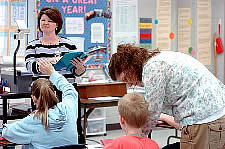
Special Education  Research studies have shown that co-teaching can be very effective for students with special needs, especially those with milder disabilities such as learning disabilities. When implemented correctly, co-teaching can be a very successful way to teach all students in a classroom setting. On the other hand, uninformed teachers can poorly implement this model which will not yield positive results for students.
Here is a basic explanation of what co-teaching means along with the benefits and different models of Co-teaching.
Research studies have shown that co-teaching can be very effective for students with special needs, especially those with milder disabilities such as learning disabilities. When implemented correctly, co-teaching can be a very successful way to teach all students in a classroom setting. On the other hand, uninformed teachers can poorly implement this model which will not yield positive results for students.
Here is a basic explanation of what co-teaching means along with the benefits and different models of Co-teaching.
The Benefits of Co-Teaching for Students with Special Needs
We all know that a student with special needs has the right to a free and appropriate public education. This is mandated under the Individuals with Disabilities Act (IDEA 2004). This law also states that a student should be educated in their least restrict environment. Ideally, this would be the general education classroom. We know this is not the best placement for all students to meet their unique learning needs. However, for those students who are included in the general education setting, I would encourage educators to consider co-teaching as a service delivery model. Research studies have shown that co-teaching can be very effective for students with special needs, especially those with milder disabilities such as learning disabilities. When implemented correctly, co-teaching can be a very successful way to teach all students in a classroom setting. On the other hand, uninformed teachers can poorly implement this model which will not yield positive results for students.
Here is a basic explanation of what co-teaching means along with the benefits and different models of Co-teaching.
Research studies have shown that co-teaching can be very effective for students with special needs, especially those with milder disabilities such as learning disabilities. When implemented correctly, co-teaching can be a very successful way to teach all students in a classroom setting. On the other hand, uninformed teachers can poorly implement this model which will not yield positive results for students.
Here is a basic explanation of what co-teaching means along with the benefits and different models of Co-teaching.
The Definition of Co-teaching:
Two or more teachers delivering instruction at the same time in the same physical space to a heterogeneous group of students (Friend and Cook, 2004).Benefits of Co-teaching:
- Students with disabilities are provided access to the general education curriculum and general education setting
- Students with disabilities will still receive specialized instruction
- Students will have the opportunity to be taught in an intense, individualized manner
- Greater instructional intensity and differentiated instruction
- Teachers will learn from each other’s expertise and expand the scope of their teaching capacity
- Reduces negative stigma associated with pull-out programs
- Students with disabilities may feel more connected with their peer group
Models of Co-teaching:
(defined by Friend and Cook, 2004).- One teach, one observe: one teacher delivers instruction while the other observes student learning and assesses student understanding and academic functioning
- One teach, one assist: one teacher will take the lead in providing instruction while the other moves around the classroom and assists students who may be struggling
- Parallel Teaching: The class is divided in half and the same material is presented at the same time by both teachers (teacher to student ratio becomes more manageable)
- Station Teaching: Both teachers are actively involved in instruction and the students rotate from one station to the next, learning new material
- Alternative Teaching: One teacher takes a small group of students and provides instruction that is different than what the large group is receiving
- Team Teaching: Both teachers instruct on the same lesson with all students present



